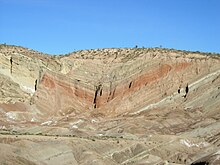The Serravallian is, in the geologic timescale, an age or a stage in the middle Miocene Epoch/Series, which spans the time between 13.82 Ma and 11.63 Ma. The Serravallian follows the Langhian and is followed by the Tortonian.
The Langhian is, in the ICS geologic timescale, an age or stage in the middle Miocene Epoch/Series. It spans the time between 15.97 ± 0.05 Ma and 13.65 ± 0.05 Ma during the Middle Miocene.
The Middle Miocene is a sub-epoch of the Miocene epoch made up of two stages: the Langhian and Serravallian stages. The Middle Miocene is preceded by the Early Miocene.
The North American land mammal ages (NALMA) establishes a geologic timescale for North American fauna beginning during the Late Cretaceous and continuing through to the present. These periods are referred to as ages or intervals and were established using geographic place names where fossil materials were obtained.
The Arikareean North American Stage on the geologic timescale is the North American faunal stage according to the North American Land Mammal Ages chronology (NALMA), typically set from 30,600,000 to 20,800,000 years BP, a period of 9.8 million years. It is usually considered to overlap the Oligocene and Miocene epochs. The Arikareean is preceded by the Whitneyan and followed by the Hemingfordian NALMA stages.
The Irvingtonian North American Land Mammal Age on the geologic timescale is the North American faunal stage according to the North American Land Mammal Ages chronology (NALMA), spanning from 1.8 million – 250,000 years BP. Named after an assemblage of fossils from the Irvington District of Fremont, California, the Irvingtonian is usually considered to overlap the Lower Pleistocene and Middle Pleistocene epochs. The Irvingtonian is preceded by the Blancan and followed by the Rancholabrean NALMA stages.
The Rancholabrean North American Land Mammal Age on the geologic timescale is the North American faunal stage according to the North American Land Mammal Ages chronology (NALMA), Named after the famed Rancho La Brea fossil site in Los Angeles, California, the Rancholabrean is characterized by the presence of the genus Bison, which appeared in northwestern North America during the Illinoian around 190-130,000 years ago, before becoming established across North America during the Sangamonian around 130-115,000 years ago. The age of the Rancho is usually considered to overlap the late Middle Pleistocene and Late Pleistocene epochs. The Rancholabrean is preceded by the Irvingtonian NALMA stage, and it is succeeded by the Santarosean age. The Rancholabrean ended around 14-12,000 years ago at the end of the Pleistocene.
The Hemphillian North American Stage on the geologic timescale is a North American faunal stage according to the North American Land Mammal Ages chronology (NALMA), typically set from 10,300,000 to 4,900,000 years BP. It is usually considered to overlap the Tortonian age of the Late Miocene and Zanclean age of the Early Pliocene. The Hemphillian is preceded by the Clarendonian and followed by the Blancan NALMA stages.
The Clarendonian North American Stage on the geologic timescale is the North American faunal stage according to the North American Land Mammal Ages chronology (NALMA), typically set from 13,600,000 to 9,000,000 years BP, a period of 3.3 million years.
The Hemingfordian on the geologic timescale is the North American faunal stage according to the North American Land Mammal Ages chronology (NALMA), typically set from 20,600,000 to 16,300,000 years BP. It is usually considered to overlap the latest Aquitanian and Burdigalian of the Early Miocene. The Hemingfordian is preceded by the Arikareean and followed by the Barstovian NALMA stages.
The Uintan North American Stage on the geologic timescale is the North American faunal stage according to the North American Land Mammal Ages chronology (NALMA), typically set from 46,200,000 to 42,000,000 years BP lasting 4.2 million years. It falls within the Eocene epoch, preceded by the Bridgerian and followed by the Duchesnean NALMA stages.
The Bridgerian North American Stage on the geologic timescale is the North American faunal stage according to the North American Land Mammal Ages chronology (NALMA), typically set from 50,300,000 to 46,200,000 years BP lasting 4.1 million years.
The Clarkforkian North American Stage, on the geologic timescale, is the North American faunal stage according to the North American Land Mammal Ages chronology (NALMA), typically set from 56,800,000 to 55,400,000 years BP lasting 1.4 million years.
The Tiffanian North American Stage on the geologic timescale is the North American faunal stage according to the North American Land Mammal Ages chronology (NALMA), typically set from 60,200,000 to 56,800,000 years BP lasting 3.4 million years.
The Puercan North American Stage on the geologic timescale is the North American faunal stage according to the North American Land Mammal Ages chronology (NALMA), spanning the interval from 66,000,000 to 63,300,000 years BP lasting 2.7 million years.

The Astaracian age is a period of geologic time, equivalent with the Middle Miocene and used more specifically with European Land Mammal Ages. It precedes the Vallesian age and follows the Orleanian age. The Astaracian overlaps the Langhian and Serravallian ages.
The Laventan age is a period of geologic time within the Middle Miocene epoch of the Neogene, used more specifically within the SALMA classification in South America. It follows the Colloncuran and precedes the Mayoan age.

The Choctaw Sea was a Cenozoic eutropical subsea, which along with the Okeechobean Sea, occupied the eastern Gulf of Mexico basin system bounding Florida.

Huilatherium is an extinct genus of leontiniid, a group of hoofed mammals belonging to the order Notoungulata, that comprises other South American ungulate families that evolved in parallel with some mammals of the Northern hemisphere. The leontiinids were a family of herbivorous species comprising medium to large browsers, with relatively short skulls and robust limbs, somewhat similar to their relatives, the best known toxodontids.
The Alajuela Formation, originally Alhajuela Formation (Tau), is a Late Miocene geologic formation in the Panama Canal Zone of central Panama.




